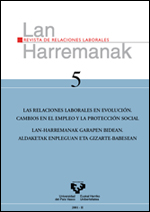La reforma negociada del sistema de Seguridad Social
##plugins.themes.bootstrap3.article.main##
##plugins.themes.bootstrap3.article.sidebar##
Abstract
The Pensions Agreement signed in April 2001 by the Government, the Comisiones Obreras Union (CC.OO), the Confederación de Organizaciones Empresariales (COE) and the Confederación Española de la Pequeña y Mediana Empresa (CEPYME), is part of a process of gradual reform which, since the Toledo Pact in 1995, has followed a constant path tending towards a Security Social minimums, inspired by the attempt to control expenditure and by the partial transfer to the market of pension funds. A growing individualist tendency in the contribution level is accompanied by an increased providing of welfare by the public system, along the lines of a reorganisation of the model of social protection, the exact outlines of which have not yet been defined. The legitimisation and social acceptance of these measures have been explicitly sought by means of the participation of the «social partners».
How to Cite
##plugins.themes.bootstrap3.article.details##
Authors who publish in the journal "Lan Harremanak" do so in agreement with the following terms:
1. Authors retain the copyright of their papers. while ceding to the journal "Lan Harremanak" the right to the first publication of their article.
2. The publisher UPV/EHU Press is a joint copyright holder, in order to protect the legitimate use of the published paper and compliance with CC terms.
3. Published papers are subject to a Creative Commons CC-BY license (unless stated otherwise) which permits third parties to share the paper, on the condition that the author and source are specified when material is reproduced.
4. Authors can enter into other non-exclusive license agreements regarding the published version of their work (e.g. depositing it in an institutional repository or re-publishing it as a monographic volume), providing the author and source are given appropriate credit.
5. Dissemination of submitted articles via Internet is both allowed and recommended (e.g. in institutional repositories and/or on the researcher's web page), both before and during the process of submission, since this can lead to interesting dialogues and also increase citations to the eventual publication.

